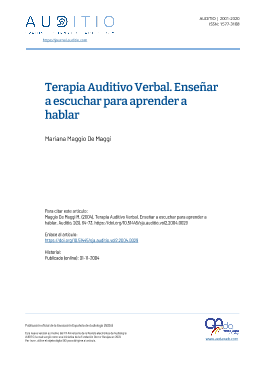Auditory-Verbal Therapy. Teach to listen to learn to speak
DOI:
https://doi.org/10.51445/sja.auditio.vol2.2004.0029Keywords:
auditory-verbal therapy, audiological assessment, pediatric hearing-aid fitting, family-centered interventionAbstract
Auditory-Verbal Therapy is a therapeutic approach to the education of deaf children where the development of auditory skills through hearing are emphasized for the acquisition of language. To do this, hearing-impaired children must be detected diagnosed and equipped with optimal amplification as early as possible. Parents are taught to create an environment where their child learns to listen, process verbal language, and speak. In this article, a brief historical review of the development of this methodology is made and its fundamental principles related to audiological evaluation, prosthetic fitting, functional use of hearing and family-centered intervention are extensively described.
Downloads
Visibility and Altmetrics
Metrics
Global Statistics ℹ️
|
7473
Views
|
36364
Downloads
|
|
43837
Total
|
|
References
The Auditory Verbal International Mission Statement.( 2001) The Auricle 13, 2. https://doi.org/10.1097/00006247-200108000-00004
Flexer, C. (1997). The Power of Hearing - audiological foundations for the development of spoken language. Paper presented at "A Sound Celebration".. Voice and Auditory Verbal International, Inc. 's 10th Anniversary Conference, Canada.
Yoshinaga-Itano C, Apuzzo ML. (1989). Identification of hearing loss after age 18 months is not early enough. Am Ann Deaf 1998 Dec;143(5):380-7. https://doi.org/10.1353/aad.2012.0151
Yoshinaga-Itano C, Sedey AL, Coulter DK, Mehl AL. (1998). Language of early- and lateridentified children with hearing loss. Pediatrics;102 (5):1161-71. https://doi.org/10.1542/peds.102.5.1161
Downs MP, Yoshinaga-Itano C. (1999). The efficacy of early identification and intervention for children with hearing impairment .Pediatr Clin North Am Feb;46(1):79-87. https://doi.org/10.1016/S0031-3955(05)70082-1
Moeller MP. (2000). Early intervention and language development in children who are deaf and hard of hearing. Pediatrics 2000 Sep;106(3):E43. https://doi.org/10.1542/peds.106.3.e43
Pollack, D. (1970). Educational Audiology for the Limited- Hearing Infant. Springfield, IL : Charles C. Thomas.
Ling, D. (1989). Foundations of Spoken Language for Hearing Impaired Children. Washington, DC:AGB. https://doi.org/10.1097/00003446-199008000-00013
Auditory -Verbal International. Scope of Practice. Easton PA. 1993.
Gravel, J. (2002). Potencial pitfalls in the audiological assessment of infants and young children. En A sound foundation through early amplification 2001. Ed. Seewald R. & Gravel, J. Phonak AG.
Boothroyd, A. (1997). Auditory Development of the hearing child. Scandinavian Audiology, 26 (S uppl.46) 9-16.
Feigin, J.A.,Kopun, J.G., Stelmachowicz, P.G. & Gorga, M.P. (1989) Probetube microphone measures of ear-canal sound pressure levels in infants and children. Ear and Hearing, 10. https://doi.org/10.1097/00003446-198908000-00008
Auditory- Verbal International. Suggested Protocol for Audiological and Hearing Aid Evaluation. The Auricle , Summer 1993.
Estabrooks, W. (1998). Cochlear Implants for kids. Washington, DC: A.G. Bell.
Talbot, P. (2003). Temas de Terapia Auditivo Verbal: Una Selección de Apuntes. Trad. Mariana Maggio De Maggi. Auditory Verbal International.
Oliver, J. (2001) en 50FAQ About AVT. Ed. Estabrooks, W. AVI.
Seewald, R.C. (1995). The Desired Sensation Level (DSL) method for hearing aid fitting in infants and childrens. Phonak Focus 20. Stäfa, Switzerland :Phonak AG.
Stelmachowicz, P.G., Kalberer, A., & Lewis, D.E. (1996). Situational Hearing Aid Response Profile (SHARP). En F.H. Bess, J.S. Gravel, & A.M. Tharpe (Eds.), Amplification for children with auditory deficits.Nashville, TN: Bill Wilkerson Center Press.
Hawkins, D.B. (1984). Comparisons of speech recognition in noise by mildly-to-moderately hearingimpaired children using hearing aids and FM systems. Journal of Speech and Hearing Disorders, 49. 1984. https://doi.org/10.1044/jshd.4904.409
Launer, S. & Kühnel , V. (2002). Signal processing for sever-to-profound hearing loss. En A sound foundation through early amplification 2001. Ed. Seewald R. & Gravel, J. Phonak AG.
Marlowe, J. (2002). Learning to listen from paradox to paradigm through early amplification. The Auricle. Vol 13 No. 1.
Hoover, B. (2001) Hearing Aid fitting in infants. The Volta Review, Volume 102 (2), 57-73. 2001.
Auditory -Verbal International . Auditory- Verbal Position Statement. The Auricle 4 (4) , 11- 15. 1991. 24. Rhoades, E. (2001). Language progress with an Uditory-Verbal approach for young children with hearing loss. International Pediatrics/Vol 16/No.1/2001.
Dornan, D. (1999).Let's Hear and Say: A current Overview of Auditoy-Verbal Therapy. The Auricle Fall/Winter. https://doi.org/10.1179/136132899805577079
Conclusiones del Primer Congreso Europeo de Familias de Deficientes Auditivos. En revista FIAPAS No.87/Julio-Agosto 2002.

Published
Versions
- 2021-09-15 (2)
- 2004-11-01 (1)
How to Cite
Issue
Section
License
Copyright (c) 2004 Auditio

This work is licensed under a Creative Commons Attribution 3.0 Unported License.
All articles will be published under the open Creative Commons Attribution (CC-BY) license. This license allows others to share and adapt the content, even for commercial purposes, as long as appropriate credit is given to the authors and the journal. By submitting their manuscript, authors retain copyright but grant the journal the right to make the first publication under this license.
More information about this license is available at: https://creativecommons.org/licenses/by/4.0/
Articles published between 2001 and 2020
The texts published in this journal in the section "AUDITIO 2001-2020" are subject - unless otherwise indicated - to a Creative Commons Attribution 3.0 Spain license. You can copy, distribute, communicate them publicly, make derivative works and commercial uses provided that you acknowledge the credits of the works (authorship, name of the journal, publishing institution) in the manner specified by the authors or by the journal. The full license can be consulted at http://creativecommons.org/licenses/by/3.0/es/deed.es.









